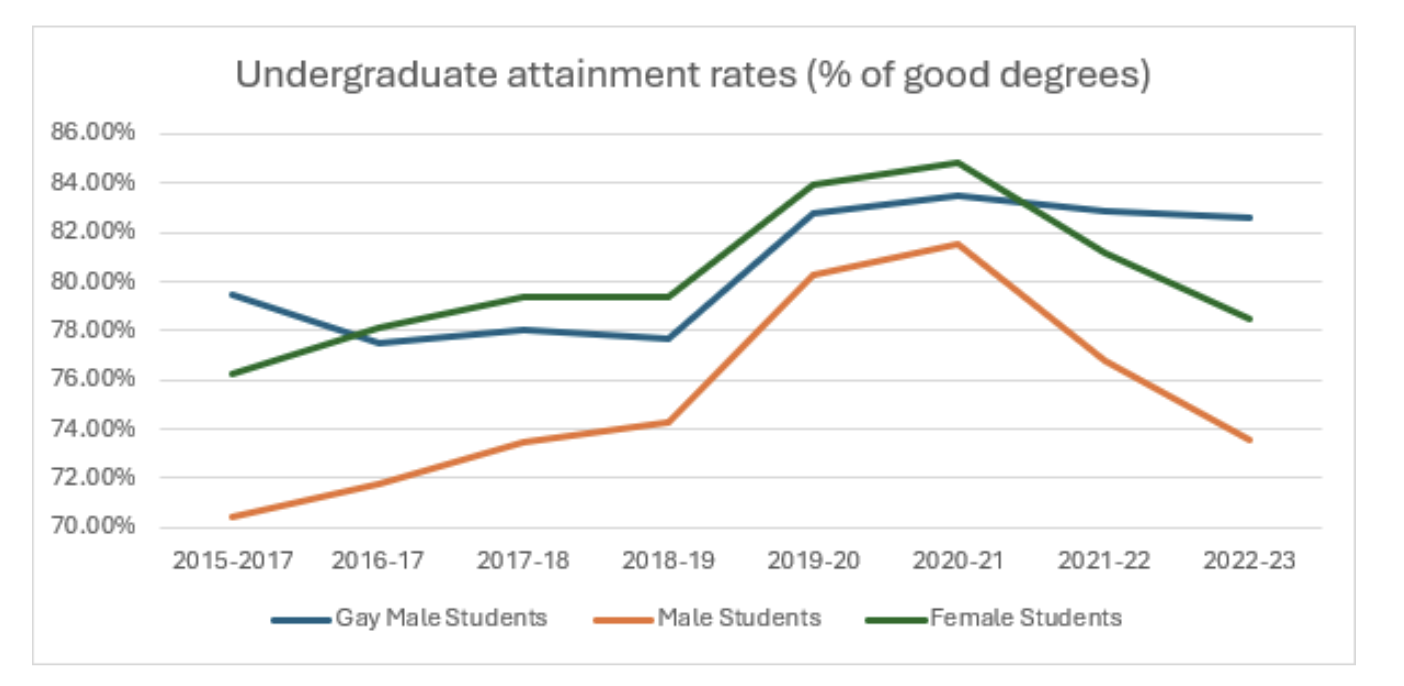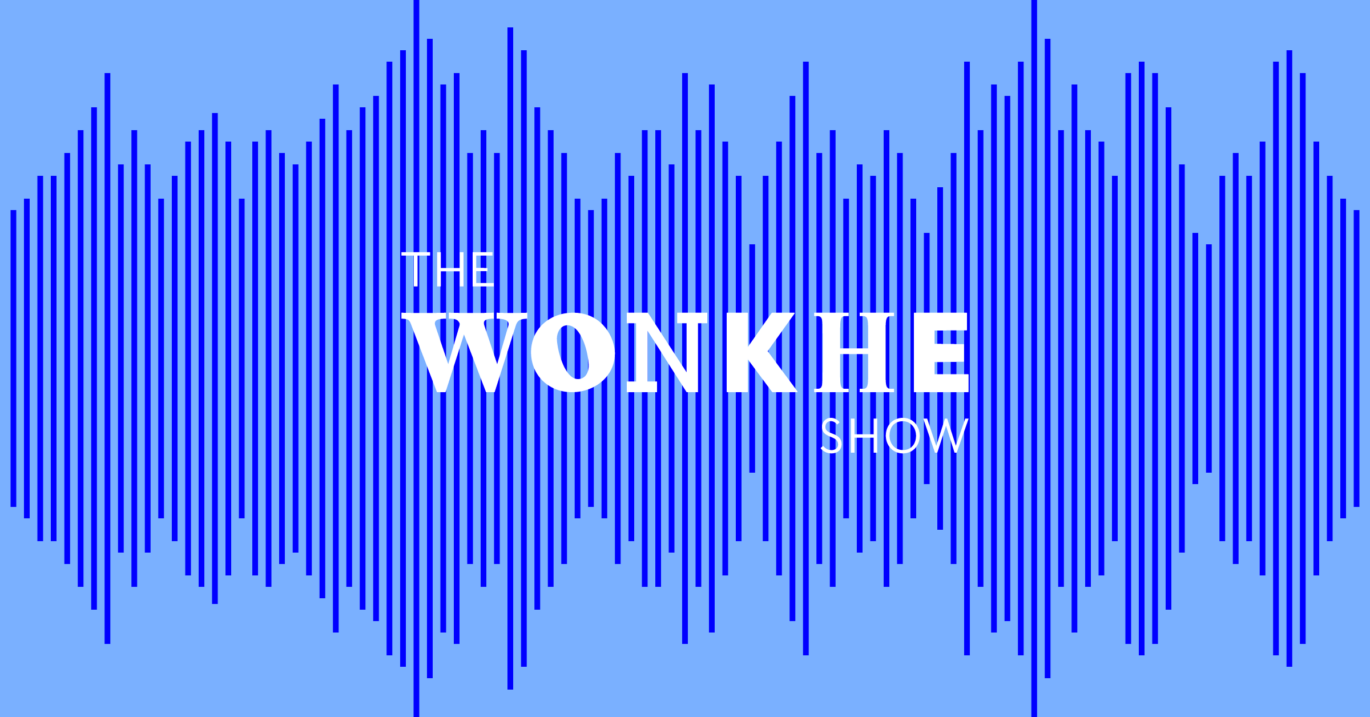The recent “Boys Will Be Boys” report from HEPI is the latest in a long-running series of warnings about a male crisis in education.
Boys and men are underperforming relative to girls and women, we’re told, and the gap grows wider each year.
While it’s true that men, overall, receive fewer “Good Degrees” (Firsts or 2:1s) than women – by a margin ranging from 3.3 to 5.1 percentage points over the last eight years – this isn’t true for all men.
In fact, gay male students have consistently outperformed not only their heterosexual male peers but, in several years, even heterosexual women. In 2022–23, 82.6 per cent of gay men achieved a Good Degree, compared with 73.6 per cent of men overall and 78.5 per cent of women.
The attainment gap looks very different when you stop treating men as a monolith, and this is evidence of exactly why we need to start resetting our mindsets around attainment gaps.

The data I draw on aren’t publicly available on the Office for Students (OfS) data dashboard, these were obtained via a Freedom of Information (FOI) request as part of my doctoral research into the “LGB attainment premium” — a term I use to describe the consistent pattern of lesbian, gay and bisexual students, outperforming their heterosexual peers in terms of degree outcomes
The absence of routinely published, intersectional data means sweeping assumptions are often made about entire groups, treating men or LGBTQ+ students as though they share a single educational experience. My research looks to understand not just why these attainment gaps exist, but what they reveal about identity, inclusion, and academic culture in higher education.
Who do we forget when we generalise men?
It’s politically expedient to speak of male underachievement in broad stroke terms, but such generalisations smooth over differences among men of various class, cultural, ethnic, or – as my research shows – sexual identities. While the HEPI report does highlight intersecting disadvantages briefly, it doesn’t probe into whether there are any advantaged male groups: in this case, gay men.
If policies and institutional strategies focus on fixing men, – or any group for that matter – higher education risks investing in universal interventions that don’t serve those already thriving. Gay men have faced systemic barriers for generations and still do – however, gay men are, on average, performing well academically in higher education.
The HEPI report references an article commissioned by Civitas and written by Jo-Anne Nadler, which claims that 24 per cent of parents believe boys are made to feel ashamed of being male at school.
The article argues that “critical social justice” is undermining schools, and positions inclusive practices — including the visibility of LGBTQ+ identities — as part of the problem. The piece presents anecdotal examples without broader data context and treats a wide range of educational themes (from decolonisation to queer theory) as a singular ideological threat.
The danger with this kind of framing is that it obscures more than it reveals. It flattens the experiences of boys and men into a single story of victimhood, without exploring where success is happening, or why. When discussions about identity and education are reduced to culture war talking points, we lose sight of the more meaningful, evidence-led questions: what works, for whom, and how can we build on that?
Hearing from the students themselves
In April 2025, I ran survey with 113 LGBTQ+ respondents at a small arts university, asking undergraduate and postgraduate students about their experiences of academic confidence, belonging, and campus culture. This aimed to question why an academic premium may exist for some marginalised groups.
Within the survey, one recurring theme stood out for gay men: a sense of needing to work twice as hard to be recognised, validated or to compensate for years of marginalisation. For some respondents in the survey, academic success functioned like armour. A rebuttal against stigma they’d faced.
This echoes findings from the United States, where researchers John Pachankis and Mark Hatzenbuehler (2013) identified a similar pattern among sexual minority men, referring to it as the “Best Little Boy in the World” hypothesis — the idea that gay men may overinvest in achievement-related domains as a deflection of the stigmatisation that has come from their sexuality.
Overperformance makes even more sense when placed in a wider economic context. The HEPI report does recognise that men, despite their academic underperformance, still earn more than women in the workplace. The picture is similar also for LGBTQ+ workers in both the United States and United Kingdom – gay men typically earn less than heterosexual men. Therefore, if the playing field is never truly even, it makes sense that those facing stigma would push themselves harder to compete in an biased labour market.
Inclusive cultures – benefitting whom?
My initial survey data suggests that inclusive campus cultures make a tangible difference. Students spoke positively about visible LGBTQ+ inclusion efforts — from staff wearing pride pin badges and inclusive posters, to active student societies and lecturers openly sharing their experiences. These small but meaningful signals were consistently linked to a stronger sense of belonging and academic attainment.
But this sense of inclusion was not experienced equally. Many queer, gender non-conforming and transgender students reported that practices such as deadnaming or misgendering created a sense of exclusion, with knock-on effects for their mental health and academic performance.
While there is an observed attainment premium for lesbian, gay and bisexual students , the trend does not extend uniformly across all LGBTQ+ groups, where queer and transgender student typically receive less good degrees. However, this picture is changing. The attainment gap for transgender students, and those whose gender is not the same as the one assigned at birth, narrowed from 6.2 percentage points in 2015–16 to just 1.5percentage points in 2022–23.
A similar trend is visible among students who identify as “other” as their sexual orientation, whose attainment gap shrank from 14 per centage points to 2.5 per cent in the same period. In other words, identity-based initiatives — often dismissed by critics as woke or virtue signalling — may, in fact, be delivering measurable academic benefits for marginalised groups.
Calling out the blind spots in policy and practice
My aim is not to ignore the fact male attainment has slipped back to its pre-pandemic low, or the broader need to support men’s success in higher education. There seems to be an impression that there is an emerging story of who feels they must try hard, and those who know they can afford not to. It’s the tortoise and the hare, however in this version, the hare still wins. The race is rigged.
The question needs to be – how can the sector make the race worth running for everyone?
The route to more effective policy is to look at men’s attainment through a finer lens – disaggregate by sexuality, race, socio-economic status, disability, and more to uncover more accurate insights. Data on gay male attainment makes it clear this isn’t just a male–female divide, and while higher performance might seem like a positive story, my initial findings, along with research by Pachankis and Hatzenbuehler, suggest that overcompensation often comes with steep costs, including burnout and persistent stress.
The HEPI report suggests that the solution may lie in assessments. In their report, they explain that men tend to perform less well in coursework-based assessments compared to exams, particularly when compared with women.
Through my FoI request to OfS, I was able to analyse attainment data by discipline and sexuality. The data shows that disciplines such as creative arts, education, and social sciences , all of which typically favour coursework over exams, are where the gay male academic premium is most typically pronounced.
Conversely, fields like environmental sciences, engineering, and architecture, which may lean toward exams or technical assessments, show lower attainment premiums for gay men. However, in stark contrast to this, the largest gay male attainment premium (9.68 percentage points) appears in natural and mathematical sciences – a field typically associated with exams. This suggests that while assessment style and disciplinary culture may influence outcomes, they are only part of the picture.
This could suggest that success in these disciplines might not indicate that the environment is more inclusive — but rather, that some gay men are excelling despite those barriers. This reinforces the need to avoid simple causal explanations, and to examine how identity, culture, and assessment interact in complex and sometimes surprising ways.
Moving beyond the monolith
While it’s convenient to lump all men into a single underachieving group, the data and lived realities show a much more complex picture than what the HEPI report offers. Yes, men overall attain fewer good degrees than women, but gay men outscore both heterosexual men and, in some cases, women.
Nikolai Elkins If the sector is actually interested in improving outcomes for all students, it can’t continue to rely on these broad narratives. Policymakers and universities need to dig into data, disaggregate by other identity factors, and examine which practices foster an environment where everyone can thrive.













Sounds like an inclusive culture would benefit gay men, but not heterosexual men, by way of maitaining the attainment gap between the two sexuality-based groups. Besides the fact of the significantly different population scales of the two groups which introduces noise to the comparison, and that the assumption of a premium related to sexuality in the context of intra- and inter-sex comparisons of attainment appears based on a single academic year (and not on the historical trend), there’s the bizarre notion that any gaps, positive or negative, are necessarily linked to the educational context (‘lived experience’ as a student), and… Read more »
I wonder if you request the intersectional attainment data from all UK universities or some of the universities. It is so different from the Learner Survey outcomes that the Uni Connect programme partnership at South Yorkshire and North Derbyshire discovered between the students who self-reported as LGPTQ+ or preferred not to say and the male or female students. The former’s likelihood to apply for a university and perceived fit-in were significantly lower than male or female students. If both of our findings are correct, we need to ask serious questions about the university admission policies. Did some of the university… Read more »